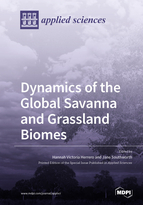Dynamics of the Global Savanna and Grassland Biomes
A special issue of Applied Sciences (ISSN 2076-3417). This special issue belongs to the section "Earth Sciences".
Deadline for manuscript submissions: closed (30 June 2020) | Viewed by 18018
Special Issue Editors
Interests: savanna systems; remote sensing; climate dynamics; time-series analysis; parks and protected areas
Special Issues, Collections and Topics in MDPI journals
Special Issue Information
Dear Colleagues,
Savanna and grassland biomes cover more of the earth's surface than any other biome type, and yet they are still largely understudied. In recent decades, global savanna and grassland ecosystems have become more prominent in the literature focused on global change dynamics. Savanna and grasslands represent unique biomes with their own challenges, both in terms of their study and in terms of their complexity, leading to many contradictory and often controversial findings. The global threats to these systems are potentially significant- from climate change impacts to human management challenges, from possible degradation to complete desertification, and looking across varied disturbance regime shifts.
This Special Issue of Applied Sciences, “Dynamics of Global Savanna and Grassland Biomes”, is intended for a wide and interdisciplinary audience, and covers recent advances in:
- drivers of vegetation dynamics
- further understanding carbon interactions in these critical landscapes
- advances in modeling both current and future system states
- tipping points in savanna systems
- human-environment interactions and challenges for management
- biodiversity and ecosystem services
Prof. Jane Southworth
Dr. Hannah Herrero
Guest Editors
Manuscript Submission Information
Manuscripts should be submitted online at www.mdpi.com by registering and logging in to this website. Once you are registered, click here to go to the submission form. Manuscripts can be submitted until the deadline. All submissions that pass pre-check are peer-reviewed. Accepted papers will be published continuously in the journal (as soon as accepted) and will be listed together on the special issue website. Research articles, review articles as well as short communications are invited. For planned papers, a title and short abstract (about 100 words) can be sent to the Editorial Office for announcement on this website.
Submitted manuscripts should not have been published previously, nor be under consideration for publication elsewhere (except conference proceedings papers). All manuscripts are thoroughly refereed through a single-blind peer-review process. A guide for authors and other relevant information for submission of manuscripts is available on the Instructions for Authors page. Applied Sciences is an international peer-reviewed open access semimonthly journal published by MDPI.
Please visit the Instructions for Authors page before submitting a manuscript. The Article Processing Charge (APC) for publication in this open access journal is 2400 CHF (Swiss Francs). Submitted papers should be well formatted and use good English. Authors may use MDPI's English editing service prior to publication or during author revisions.
Keywords
- savanna science
- climate variability and change
- vegetation dynamics
- carbon
- ecosystem services
- modeling
- human dimensions
- tipping points
- disturbance and degradation







